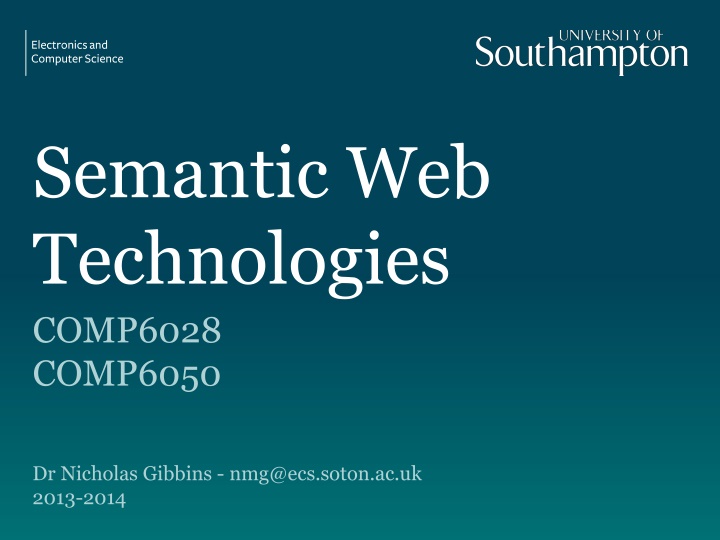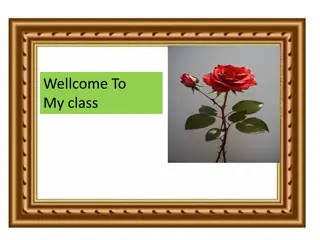
Semantic Web Technologies: COMP6028 vs COMP6050 Modules
Explore the concepts and applications of Semantic Web technologies, compare COMP6028 and COMP6050 modules, understand course aims, structure, and assessment details, and delve into the teaching schedule covering various topics related to the Semantic Web.
Download Presentation

Please find below an Image/Link to download the presentation.
The content on the website is provided AS IS for your information and personal use only. It may not be sold, licensed, or shared on other websites without obtaining consent from the author. If you encounter any issues during the download, it is possible that the publisher has removed the file from their server.
You are allowed to download the files provided on this website for personal or commercial use, subject to the condition that they are used lawfully. All files are the property of their respective owners.
The content on the website is provided AS IS for your information and personal use only. It may not be sold, licensed, or shared on other websites without obtaining consent from the author.
E N D
Presentation Transcript
Semantic Web Technologies COMP6028 COMP6050 Dr Nicholas Gibbins - nmg@ecs.soton.ac.uk 2013-2014
Course Aims Understand the key ideas and history behind the Semantic Web Explain the state of the art in Semantic Web technologies Gain practical experience of ontology design in OWL Understand the future directions of the Semantic Web, and its relationship with other Web developments
COMP6028 vs COMP6050 Two variant modules: COMP6028 is a 20 credit module COMP6050 is a 10 credit module Teaching is shared between COMP6028 and COMP6050 Assessment differs between modules
Course Structure Two lectures per week, plus occasional tutorial session Wednesday 0900-1000 in 02/1039 Thursday 1200-1300 in 35/1005 Friday 1600-1700 in 45/0045 (tutorial)
Teaching Schedule Week 18: Introduction to the Semantic Web Week 19: Ontologies and Description Logic Week 20: RDF and RDFS Week 21: Linked Data Week 22: Description Logic Week 23: OWL
Teaching Schedule Week 24: Ontology Engineering and Patterns Week 29: SPARQL Week 30: RDFa, GRDDL and POWDER Week 31: Rules Week 32: Semantic Web and Web2.0 Week 33: Review
COMP6028 Assessment Examination: 50% (90 minutes, 3 questions from 5) Ontology design coursework: 20% Specification published in week 20 Submission due week 26 Feedback due week 31 Individual report: 30% Subjects published in week 20 Submission due week 31
COMP6050 Assessment Examination: 60% (60 minutes, 2 questions from 4) Ontology design coursework: 40% Specification published in week 20 Submission due week 26 Feedback due week 31
Introduction to the Semantic Web
History of the Semantic Web The World Wide Web was invented by Tim Berners-Lee (amongst others), a physicist working at CERN TBL s original vision of the Web was much more ambitious than the reality of the existing (syntactic) Web TBL (and others) have since been working towards realising this vision, which has become known as the Semantic Web
History of the Semantic Web ... a goal of the Web was that, if the interaction between person and hypertext could be so intuitive that the machine- readable information space gave an accurate representation of the state of people's thoughts, interactions, and work patterns, then machine analysis could become a very powerful management tool, seeing patterns in our work and facilitating our working together through the typical problems which beset the management of large organizations. T. Berners-Lee, The World Wide Web: Past, Present and Future, 1996
What is the Semantic Web? The Semantic Web is an extension of the current Web in which information is given a well- defined meaning, better enabling computers and people to work in cooperation. It is the idea of having data on the Web defined and linked in a way that it can beused for more effective discovery, automation, integration and reuse across various applications. The Web can reach its full potential if it becomes a place where data can be processed by automated tools as well as people. W3C Activity Statement
The annotated Web Enrich existing web pages with annotations Classify web pages Use natural language techniques to extract information from web pages Annotations enable enhanced browsing and searching (but NLP is hard)
The Web of Data Expose existing databases in a common format Express database schemas in a machine-understandable form Common format allows the integration of data in unexpected ways Machine-understandable schemas allow reasoning about data (make the most of the structure you already have)
Rocket Science (not) Is this rocket science? Well, not really. The Semantic Web, like the World Wide Web, is just taking well established ideas, and making them work interoperably over the Internet. This is done with standards, which is what the World Wide Web Consortium is all about. We are not inventing relational models for data, or query systems or rule-based systems. We are just webizing them. We are just allowing them to work together in a decentralized system - without a human having to custom handcraft every connection. Tim Berners-Lee, Business Case for the Semantic Web, http://www.w3.org/DesignIssues/Business
The Origins of the Semantic Web
Interwoven themes Knowledge Based Systems Library and Information Science Hypertext and Hypermedia
Metadata The origins of the Semantic Web lie in metadata Metadata is data about data A webpage is data A description of the webpage is metadata Metadata for a webpage could include author date of publication file size Library cataloguing = metadata
Beyond metadata The scope of the modern Semantic Web goes beyond bibliographic metadata for webpages Metadata is still just data If we have an infrastructure for metadata, we can use it for data in general
Knowledge representation Long-standing discipline within Artificial Intelligence (the Semantic Web has a strong heritage!) Knowledge representation languages should: Handle qualitative knowledge Allow new knowledge to be inferred Represent both the general and the specific Capture complex meaning Allow meta-level reasoning RDF, RDF Schema and OWL are knowledge representation languages
Network knowledge representation Traditional knowledge representation is formal logic Network knowledge representation originated in 1960s with psychologists and linguists Knowledge is represented as a graph Nodes are objects or concepts Edges are relations or associations action bark Dog brown colour is a Fido steak eats
Vocabularies and ontologies A knowledge representation language by itself is of little use We need to be able to tailor the language to our application domain The bibliographic domain needs to be able to talk about works and authors The e-commerce domain needs to be able to talk about orders and prices We need domain-specific vocabularies and ontologies
Hypertext and hypermedia Non-linear writing Interlinked texts Multiple pathways, multiple reading sequences Multiple media: video, audio, images, emails, databases, spreadsheets Annotation and commentary Association of ideas
Links Essence of hypermedia is connections Relationships in an abstract domain Implemented as navigable links Many kinds of relationships Author-of, homepage-of, see-also, background-info, definition, more- detail Typed links Links are complex structures Multivalent, rich metadata Not just simple GOTOs
Open Hypermedia Links should be first-class objects manipulated independently supports explains quotes comments on describes defines supports refutes
Open hypermedia versus network KR Open hypermedia makes links between different bits of knowledge Knowledge is expressed as text, images, etc Network knowledge representation makes links that are knowledge Are typed hypermedia links knowledge? Is a set of hypermedia link types an ontology?
The World Wide Web vs. the Semantic Web The World Wide Web is the Web for people Information is predominantly textual Technologies include URI, HTTP, XML, HTML The Semantic Web is the Web for machines Information needs to be structured Technologies include RDF, RDFS, OWL (in addition to those for the Web)
Machine readable vs. machine understandable On the World Wide Web, information needs humans to give it interpretation Information is predominantly natural language Difficult to mediate by software agents On the Semantic Web, information is structured so that it can be interpreted by machines Humans need not interact directly with Semantic Web information mediation through agents Formal meaning is critical to understanding
Machine readable vs. machine understandable XML is a machine readable format It can be parsed to give an unambiguous document structure but It has no formal meaning Meanings of XML interchange formats must be explicitly agreed
Machine readable: XML <foo bar= 2003386947 > <baz qux= 19J >502-224</baz> <quux>2</quux> <quuux>3998SB</quuux> </foo> foo bar=2003386947 baz quux quuux quz=19J 502-224 2 3998SB
Machine readable: XML <order ref= 2003386947 > <part catalogue= 19J >502-224</part> <quantity>2</quantity> <customer>3998SB</customer> </order> order ref=2003386947 part quantity customer catalogue=19J 502-224 2 3998SB
Machine readable vs. machine understandable RDF is a machine understandable format The structures generated by an RDF parser have a formal meaning RDF is a framework for interchange formats that provides a base level of common understanding RDF provides basic notions of classes and properties RDF enables simple inference RDF permits certain types of deduction to be made from existing knowledge
Semantic Web Technical Architecture
Fundamental Principles Anyone can make assertions about anything Entities are referred to using Uniform Resource Identifiers Based on XML technologies Formal semantics
The Semantic Web layer cake User Interface and Applications Attribution Trust Proof Explanation Encryption OWL Rules Ontologies + Inference SPARQL (queries) Signature RDF Schema Metadata RDF XML + Namespaces Standard syntax Identity URI Unicode
Languages of the Semantic Web 1996 PICS MCF SHOE 1997 1998 RDF(S) 1999 OIL DAML 2000 DAML+OIL 2001 2002 RDF(S) OWL 2003 2004 2005 2006 OWL 1.1 2007 W3C Language 2008 Other OWL 2 2009
The triple Underlying model of triplesused to describe the relations between entities in the Semantic Web (subject, predicate, object) e.g. RDF Semantics , edited by , Pat Hayes edited by RDF Semantics Pat Hayes subject predicate object Network knowledge representation Labelled, directed graph Entities as nodes, relations as edges
Example Take a citation: Tim Berners-Lee, James Hendler and Ora Lassila. The Semantic Web. Scientific American, May 2001 We can identify a number of distinct statements in this citation: There is an article titled The Semantic Web One of its authors is a person named Tim Berners-Lee (etc) It appeared in a publication titled Scientific American It was published in May 2001
Example We can represent these statements graphically 2001-05 The Semantic Web date Tim Berners-Lee title name creator James Hendler name publishedIn creator Ora Lassila creator name title Scientific American
Example There are two types of node in this graph: Literals, which have a value but no identity (a string, a number, a date) Scientific American Resources, which represent objects with identity (a web page, a person, a journal)
Example Resources are identified by URIs Property labels are also identified by URIs, and are drawn from a vocabulary or ontology http://purl.org/dc/elements/1.1/title Scientific American http://www.sciam.com/
Blank nodes (bNodes) Sometimes we have resources which we do not wish to identify with a URI These are blank nodes or anonymous resources creator name John Smith http://www.example.org/
Resource Description Framework
Resource Description Framework RDF is a language for representing information about resources on the World Wide Web and beyond RDF uses Uniform Resource Identifiers to identify things and the relations between them XML-based standard syntax for RDF
RDF Vocabulary Description Language (RDF Schema)
Limitations of RDF RDF lets us make assertions about resources using a given vocabulary RDF does not let us define these domain vocabularies by itself RDF Schema is an RDF vocabulary which we can use to define other vocabularies
Defining an RDF vocabulary Define classes of objects and their relationship with other classes there is a class called Employee which is a subclass of the class called Person Define properties that relate objects together and their characteristics there is a property called worksFor which relates objects of class Employee to objects of class Company
Using RDF to define RDFS RDFS is an RDF vocabulary which contains: Classes for defining classes and properties Properties for defining basic characteristics of classes and properties Ancillary properties to aid curation
Web Ontology Language (OWL)



